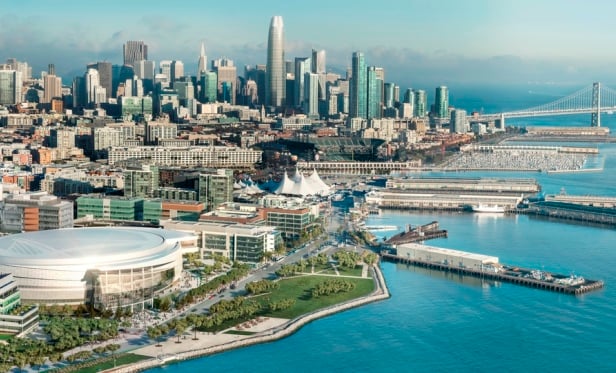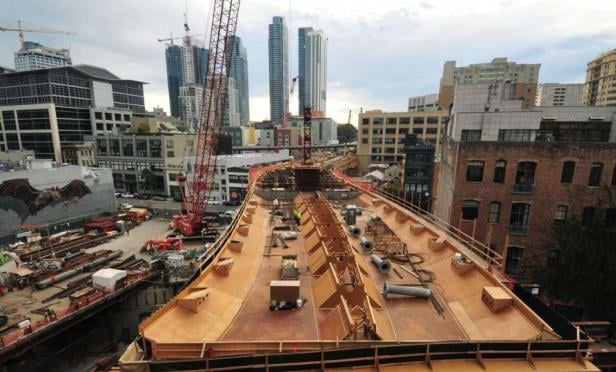NEW YORK CITY–To address the predicted impacts of climate change, New York City Mayor Bill de Blasio has issued a new set of “climate resiliency design guidelines” for new construction and renovations to existing city buildings and infrastructure.
The new guidelines, released on Friday, have been well received by environmental groups as well as from the building industry. The guidelines, advanced by the Mayor's Office Of Recovery And Resiliency, provide architects, engineers, planners instructions on how to incorporate anticipated changes in temperature, precipitation, and sea levels into the design of city facilities.
The guidelines are based on what city officials say is the “best available science provided by the New York City Panel on Climate Change.” The guidelines are to be used throughout the design process–from the conceptual phase to final design–for all new construction and substantial improvements of city buildings and infrastructure. Utilization of the guidelines will result in enhanced standards that will make new and renovated buildings, as well as infrastructure, more resilient to extreme weather and climate change, they add.
“New York is meeting the challenge of climate change head-on, and in the process we are building a better city,” says Mayor de Blasio. “These guidelines are another national first, and will make the city's buildings and infrastructure more resilient in the face of rising seas, extreme heat and storms. Our forward-looking approach will help us prepare for the effects of climate change, so the next generation can continue to call New York home.”
Carlo A. Scissura, president, CEO of the New York Building Congress, in a statement released to Globest.com, praised the new resiliency guidelines. “Mayor Bill de Blasio's Climate Resiliency Guidelines solidify New York City's position as a leader in climate action,” he says. “The guidelines, which make the city the first in the nation to integrate multiple climate risks into its capital program, are critical steps to ensure that the built environment is more resilient, critical infrastructure is stronger, and our coastal communities are protected.”
He adds that the New York Building Congress is looking forward to working with the mayor “to build and safeguard the city's infrastructure from future risks and promote the health and prosperity of residents and communities throughout the five boroughs.”
The Real Estate Board of New York had no comment at press time on the mayor's new climate resiliency guidelines.
Daniel Zarrilli, senior director for climate policy & programs and the chief resilience officer in the mayor's office, says, “These design guidelines are a critical way that New York City will institutionalize the work of resiliency into the ways we design and build our infrastructure, leveraging our existing spending to ensure that we are continuing to build a more resilient city.”
Among some of the key guidelines proposed by the mayor include: providing guidance to address major climate risks and planning for continued changes in climate across the entire useful life of newly built facilities; ensuring that both critical and non-critical city facilities are designed to be resilient; ensuring cost-effective investments are made by evaluating the future climate projections against the service life of a planned new asset and utilizing projected climate data at the local level.
The mayor also recommends that large-scale projects undertake a full-climate risk assessment in order to develop a resilient design specific to the facility. The guidelines also seek to address urban flooding from extreme precipitation and recommend use of flexible adaptation pathways, a way of designing facilities with coastal storms protections that can be upgraded as a means to manage uncertainty.
New York City Department of Environmental Protection acting commissioner Vincent Sapienza, says of the city's resiliency initiatives, “New York City already has the largest and most aggressive green infrastructure program in the nation, we are expanding our award-winning Bluebelt program and are engaged in a comprehensive upgrade to the city's vital wastewater systems to ensure they are resilient against rising sea levels. All of this work will help ensure that we leave a strong and just city to the next generation.”
The city will review and pilot the resiliency guidelines on projects through the rest of 2017. The results will be used to refine the preliminary draft and a final version will be released in December 2017.
The new guidelines, released on Friday, have been well received by environmental groups as well as from the building industry. The guidelines, advanced by the Mayor's Office Of Recovery And Resiliency, provide architects, engineers, planners instructions on how to incorporate anticipated changes in temperature, precipitation, and sea levels into the design of city facilities.
The guidelines are based on what city officials say is the “best available science provided by the
“
Carlo A. Scissura, president, CEO of the
He adds that the
The Real Estate Board of
Daniel Zarrilli, senior director for climate policy & programs and the chief resilience officer in the mayor's office, says, “These design guidelines are a critical way that
Among some of the key guidelines proposed by the mayor include: providing guidance to address major climate risks and planning for continued changes in climate across the entire useful life of newly built facilities; ensuring that both critical and non-critical city facilities are designed to be resilient; ensuring cost-effective investments are made by evaluating the future climate projections against the service life of a planned new asset and utilizing projected climate data at the local level.
The mayor also recommends that large-scale projects undertake a full-climate risk assessment in order to develop a resilient design specific to the facility. The guidelines also seek to address urban flooding from extreme precipitation and recommend use of flexible adaptation pathways, a way of designing facilities with coastal storms protections that can be upgraded as a means to manage uncertainty.
The city will review and pilot the resiliency guidelines on projects through the rest of 2017. The results will be used to refine the preliminary draft and a final version will be released in December 2017.
Want to continue reading?
Become a Free ALM Digital Reader.
Once you are an ALM Digital Member, you’ll receive:
- Breaking commercial real estate news and analysis, on-site and via our newsletters and custom alerts
- Educational webcasts, white papers, and ebooks from industry thought leaders
- Critical coverage of the property casualty insurance and financial advisory markets on our other ALM sites, PropertyCasualty360 and ThinkAdvisor
Already have an account? Sign In Now
*May exclude premium content© 2024 ALM Global, LLC, All Rights Reserved. Request academic re-use from www.copyright.com. All other uses, submit a request to [email protected]. For more information visit Asset & Logo Licensing.









